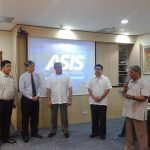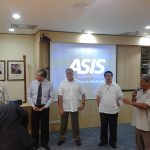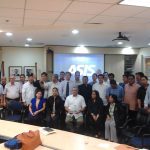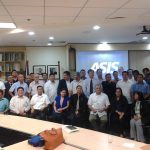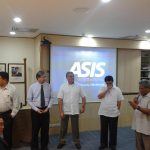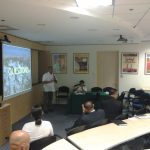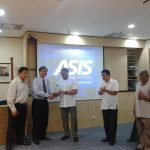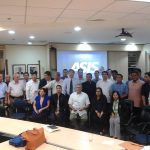You come home from work at 5 p.m. only to find yourself stuck in a kilometer-long traffic jam. Commuters swarm the MRT stations, people living in depressed areas begin evacuating their homes, the Metro is flooded with water levels climbing 3- to 4-feet high. Although the situation you’re at is a far cry from the likes of Typhoon Ondoy (International name: Ketsana), there are definitely economic losses incurred in terms of delays and minor displacements of people and property. Others might say that the situation illustrates that of a disaster. For those of us who’ve experienced real disasters, the flooding situation during monsoon rains is nothing more than a regular urban problem. The United Nations (UN) share a similar view.
The UN perspective in disaster preparedness and recovery is a hot topic in the presentation delivered by UN Regional Security Advisor William Wairoa-Harrison, MSc., during the 5th Monthly Meeting of the ASIS International – Philippines Chapter at the United Nations office, RCBC Plaza, Makati City, Metro Manila, Philippines on July 28, 2013.
Mr. Wairoa-Harrison, fondly called Willie by his friends, shared in-depth and straightforward ideas to asset protection professionals. With police and military background, a career spanning more than a decade in risk management and security assessment for the United Nations, a Master’s degree in Security and Risk Management from the University of Leicester, it is easy to figure how he currently landed the elite post of Regional Security Advisor for the Philippines and Japan at the United Nations Department of Safety and Security (UNDSS).
His presentation, entitled “Disaster Preparedness and Recovery: A Global Perspective,” started with a video presentation of the UN Development Program’s “Act now, save later” advocacy. The video highlighted the different statistics that featured the significant impact of preparation to overall safety and recovery. The UN video indicated that since year 2000, almost one million people in the world got killed and more than two billion got affected by disasters. It further detailed that more than one trillion US dollars got lost to disasters. In contrast, only 1% of international aid money is spent to reduce the impact of disasters, and of this, only 10 % is allotted to protect development gains and improve safety conditions to save thousands of lives and billions of properties. The video finally stated that every 1 dollar spent on disaster preparedness saves 7 dollars in response. “We cannot eliminate disasters, but we can mitigate risk. We can reduce damage and can save more life,” UN Secretary General Ban Ki-Moon was quoted as saying.
Gallery (Photos Courtesy of ASIS International-Philippine Chapter)
Mr. Harrison went on to state the UN official definition for disasters: “A serious disruption of the functioning of a community or a society causing widespread human, material, economic or environmental losses which exceed the ability of the affected community or society to cope using its own resources.” The definition further adds that it results from a combination of factors which involve, among others, “an insufficient capacity or measure to reduce the potential negative consequences of risk.” Mr. Harrison highlighted two counts in the UN’s definition of disaster. One, that it must register “widespread human, material, economic or environmental losses.” Thus, UN does not count the regular flooding in Metro Manila a disaster, albeit causing definite economic losses. Second, the definition highlights the importance of disaster preparedness in assessing the scope of a disaster.
The UN’s official definition is important in several respects. Mr. Harrison highlighted that the multilateral agency can only lend help to a nation requesting aid for a perceived calamity if the same situation fits that of the description that UN follows for a “disaster.” Atty. Paul Yusi, ASIS Chapter Chairman, through a comment, underscored the significance of UN’s definition in requesting for UN aid and relief response to which Mr. Harrison agreed, “The United Nations cannot grant aid in situations that does not fit its description of a disaster.”
Mr. Ace Esmeralda, SecurityMatters Editor-in-Chief and Assistant Regional Vice President Region 33-Philippines of ASIS International, highlighted in a comment that the significance of the definition to the Philippines, one of the world’s most disaster-prone areas in the world, lies on the nation’s ability to access support in times of disaster. Mr. Harrison agreed, adding that of the two countries where he is tasked to advise on matters in disaster at the UN (Philippines and Japan), the Philippines has a more established response plan linkage with the United Nations. “Japan is a donor country for the United Nations. They expect themselves to give to UN than receive. During the Fukushima-Daichi nuclear disaster, it even took the Japanese government a long time before finally asking for help at the United Nations. And when they did, they only asked for a very small amount of help,” Mr. Harrison explained.
The UN also prescribes elaborate protocols for disaster preparedness and disaster recovery. Mr. Harrison explained that disaster preparedness is a six-pronged process in the UN standard: disaster risk management, preparedness, prevention, early warning system, mitigation, and contingency planning. He particularly commended the Philippines for excellence in early warning system as exhibited in the promptness of PAGASA in giving heads-up to areas of possible calamities. Disaster recovery, on the other hand, is two-pronged: emergency relief/response, which is the provision of assistance during and immediately after the disaster, and recovery, which is the rehabilitation and reconstruction of affected communities.
While Mr. Harrison commends the Philippines for its “excellent” disaster coordination mechanism, the private sector, too, had their own burden in sharing with the route to prevention and recovery. Mr. Jaime Chua who represented BDO, during the open forum, mentioned that BDO and other banks have an elaborate contingency and recovery plan in cases of a disaster, such as recovery loans for businesses and individuals. Representatives from other government and private sectors likewise shared each of their enterprise’s disaster mitigation plans, while others made sure to take note of the inputs during the meeting in creating and improving their disaster risk mitigation and recovery procedures.
Mr. Harrison concluded that disaster preparedness is just one element of a holistic approach to the reduction of risk associated with natural and man-made hazards. However, an adequate level of preparedness can be particularly essential to saving lives and livelihoods in the face of a natural hazard event. He stressed that key indicators of effective preparedness and capabilities should lead to the following outputs:
- Realistic and measurable objectives, outputs, and activities to strengthen and maintain disaster preparedness capabilities that are an integral component of a holistic national disaster risk reduction strategy.
- An approved national legislative framework that details disaster preparedness, response, recovery roles, responsibilities and funding mechanisms. The Framework when developed needs to be updated, widely disseminated and consistently implemented.
- A well-functioning disaster coordination mechanism is in place with clear policies and procedures and in which all entities are clear about their roles and responsibilities.
- A contingency plan that includes an in-depth analysis of hazard risk, vulnerability and capacities is developed and regularly updated and exercised. All organisations, persons and volunteers responsible for maintaining preparedness are equipped and trained for effective disaster preparedness and response.
- An effective national and regional early warning system that applies sound scientific information and risk knowledge is in place and able to communicate warnings to mobilise action in all at-risk communities.
- An information management and dissemination system that facilitates the two-way exchange of pertinent technical and management information between internal and external stakeholders is maintained.
- Multi-stakeholder response mechanisms, supported by legislation and accompanied by the necessary resources, are developed and tested based on the contingency plan, enabling efficient action during times of emergency.
- The transition to early recovery activities is considered and planned for in contingency and other preparedness planning processes.
- Financial reserves and emergency funding mechanisms are in place to support effective preparedness, response and early recovery as required.
Mr. Harrison lastly warned that preparedness planning is a process that requires constant and sustained vigilance and that developing a preparedness capability is only the first step. Once the basic preparedness activities have been undertaken, it is critical that human and other resources are allocated to maintain and update systems, and that lessons learned in the wake of disasters are used to strengthen preparedness in the future.


